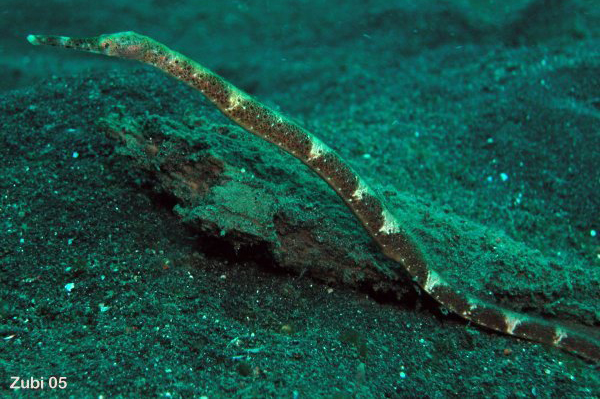Straightstick Pipefish, Trachyrhamphus longirostris Kaup 1856

Straightstick Pipefish, Trachyrhamphus longirostris. Source: Teresa Zubi / http://www.starfish.ch/. License: All rights reserved
A plain or mottled brown to greyish pipefish, often with pale scribbly markings on the head and a series of fine pale diamond-shaped markings on the sides. This large pipefish lies motionless on the bottom, lifting its head slightly to feed on small crustaceans.
Straightstick Pipefish, Trachyrhamphus longirostris Kaup 1856
More Info
|
Distribution |
Tropical Indo-west Pacific, known from the Red Sea and East Africa, eastwards to the Western Pacific (including Indonesia, the Philippines, Australia, Papua New Guinea, the South China Sea, Japan). Recorded in Australian waters from North West Cape, Western Australia, northwards around the tropical north to about Magnetic Island, Queensland. Most specimens have been trawled or dredged from muddy to sandy-bottom habitats in depths of 16-91m, in association with sand, rubble, seagrasses, algae, sponges, sea pens and hydroids. |
|
Features |
Meristics: D 26–30; P 16–19 (usually 17–18); trunk rings 21–24; tail rings 42–53; subdorsal rings 3.75–2.25 + 1.75–3.25 = 4.75–6.0. Head and Body: Body elongate; superior trunk and tail ridges discontinuous; trunk ridge arched dorsally on subdorsal rings; inferior trunk ridge ends on anal ring; lateral trunk ridge confluent with inferior tail ridge; snout length 1.9–2.1 in HL, snout depth 4.8–7.0 in HL; median dorsal snout ridge a little elevated above nostrils, essentially straight in small specimens, the ridge usually with minute denticulations and curved in most adults; opercle usually with a low, complete or incomplete ridge angled upward toward gill opening; principle body ridges low, essentially entire; scutella not keeled. Fins: Dorsal fin origin on trunk, fin base somewhat elevated; caudal fin rounded in most subadults-adults, sometimes more or less stubby in very large individuals; pectoral fin base without distinct ridges. |
|
Size |
Maximum length 40 cm. |
|
Colour |
Usually tan to brownish (or even greyish) in colour, and either plain or mottled, usually without distinctive markings, sometimes with 12–13 diffuse dark bars crossing dorsal surface and sides of body. The snout is often darker than the body. Caudal fin brown, shading to pale distally. |
|
Feeding |
Straightstick Pipefish usually remain very close to the substrate and are likely to feed on small benthic crustaceans such as amphipods. |
|
Biology |
Females lay eggs that are brooded by the males in a semi-enclosed pouch under the tail, with slightly enlarged pouch plates and pouch folds. Males are likely to be brooding at 150–160 mm SL. Juveniles (78–85 mm SL) have a broadly-flattened dermal flap above each eye and two pairs of elongate dermal appendages on the dorsal surface of tail towards the posterior end. |
|
Fisheries |
Straightstick Pipefish are taken as bycatch in Australia’s Northern Prawn Trawl fishery. The species is also collected for the aquarium trade, and sold as curios or for use in the Traditional Chinese Medicine Trade. |
|
Conservation |
Australian Commonwealth legislation: Marine listed under the Environment Protection and Biodiversity Conservation Act 1999 (EPBC Act). |
|
Remarks |
Geographic variation in the numbers of tail rings and total rings indicates that some populations may represent different species. |
|
Similar Species |
Trachyrhamphus longirostris is most similar to the more common T. bicoarctatus, differing in having the head at a less acute angle to the body, in the absence of appendages on the trunk of planktonic juveniles, in having fewer tail rings (41–53 versus 55–63). T. longirostris also stays closer to the substrate, not raising the body to feed on planktonic crustaceans. |
|
Etymology |
Trachyrhamphus is from the Greek trachys, -eia, -ys (rough) and rhamphos (bill). The specific name longirostris is from the Latin longus (long) and rostrum (snout, bill, beak) in reference to the long snout. |
|
Species Citation |
Trachyrhamphus longirostris Kaup 1856, Cat. Lophobranchiate Fish: 24. Type locality: China. |
|
Author |
Dianne J. Bray & Vanessa J. Thompson |
Straightstick Pipefish, Trachyrhamphus longirostris Kaup 1856
References
Dawson, C.E. 1984. Review of the Indo-Pacific Pipefish genus Trachyrhamphus (Syngnathidae). Micronesica 18: 163–191.
Dawson, C.E., F. Yasuda & C. Imai. 1979. Elongate dermal appendages of Yozia (Syngnathidae) with remarks on Trachyrhamphus. Japanese Journal of Ichthyology 25(4): 244-250.
Dawson, C.E. 1985. Indo-Pacific Pipefishes (Red Sea to the Americas). Gulf Coast Research Laboratory, Ocean Springs, Mississippi. 230 pp.
Kaup, J.J. 1856. Catalogue of the Lophobranchiate Fish in the Collection of the British Museum. British Museum, London. 76 pp.
Kuiter, R.H. 1996. Guide to Sea Fishes of Australia. New Holland, Frenchs Forest, NSW, Australia, 434pp.
Kuiter, R.H. 2009. Seahorses and their relatives. Aquatic Photographics, Seaford, Australia. Pp. 1–333.
Larson, H.K. & Williams, R.S. 1997. Darwin Harbour Fishes: A Survey and Annotated Checklist, In Hanley, J.R., Caswell, G., Megirian, D. & Larson, H.K. (Eds) Proceedings of the Sixth International Marine Biological Workshop. The marine flora and fauna of Darwin Harbour, Northern Territory, Australia. Museums and Art Galleries of the Northern Territory and the Australian Marine Sciences Association: Darwin, Australia, 1997 pp.339-380.
Michael, S.W. 1998. Reef Fishes Volume 1. A Guide to Their Identification, Behaviour and Captive Care. Microcosm Ltd., Shellbourne, Vermont, 624 pp.
Paxton, J.R., J.E. Gates, D.F. Hoese & D.J. Bray. 2006. Syngnathidae (Pp. 810–846). In Beesley, P.L. & Wells, A. (Eds) Zoological Catalogue of Australia. Volume 35. Fishes. ABRS & CSIRO Publishing, Australia., 3 vols.
Pogonoski, J.J., D.A. Pollard & J.R. Paxton. 2002. Conservation Overview and Action Plan for Australian Threatened and Potentially Threatened Marine and Estuarine Fishes, Environment Australia, Canberra. 375 pp.

